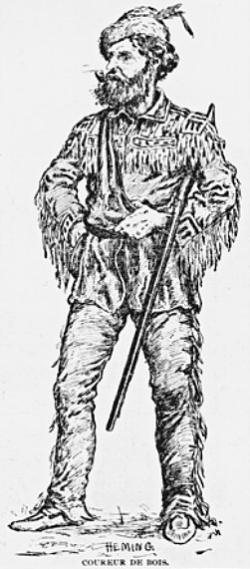 SKC Films Library |
| SKC Films Library >> American History >> United States: Local History and Description >> The West >> Missouri River and Valley |
| Sieur de Bourgmont leader of an expedition in the Missouri River Valley that established relations with Kanza and Paducah Indians
M. Étienne Venyard, Sieur de Bourgmont, was born in Normandy, France, in 1679. In 1698, he was arrested for poaching on monastery land, and chose to leave for New France (Canada) rather than pay the fine. How Bourgmont initially supported himself after arriving in New France is unknown, but by 1706 he was a Lieutenant of Fort Ponchartrain du Detroit under the command of Antoine Laumet de La Mothe, sieur de Cadillac. In March of 1706, a group of Ottawa Indians attacked a group of Miami Indians outside the fort; soldiers fired on the disturbance from the fort and French priest and sergeant who happened to be outside the walls at the time, along with 30-some Ottawas. By the time Cadillac learned of the incident and returned to the fort Bourgmont was gone. Bourgmont spent the next several years living among Indians on the Missouri River; he finally returned to Fort Ponchartrtain in 1712. In 1713, Bourgmont began writing Exact Description of Louisiana, of Its Harbors, Lands and Rivers, and Names of the Indian Tribes That Occupy It, and the Commerce and Advantages to Be Derived Therefrom for the Establishment of a Colony. In 1714, he traveled to the mouth of the Platte River, which he called Rivière Nebraskier, after the Otoe name for "flat water", and wrote The Route to Be Taken to Ascend the Missouri River. In 1718 he received the Cross of Saint Louis in recognition of his service to France through his explorations, and in 1719 the Council of the Colony of Louisiana recognized his work with Native Americans with a commendation. On August 12, 1720, Bourgmont was commissioned to lead an expedition to make peace with the Native Americans of New Mexico and to establish a French post on the Missouri River. He accomplished the latter task in 1723, when he established Fort Orleans; the exact location of the fort has never been conclusively determined, but it was believed to have been an island in the Missouri River near its junction with the Grand River, near present-day Brunswick, Missouri. Bourgmont set out on his principal mission in the summer of 1724. He entered a Kanza village near present-day Doniphan, Kansas on July 8th, and spent more than two weeks exchanging gifts and negotiating treaties. On July 24th he and about 300 Kanza warriors, 800 women and children, and 300 dogs set out to establish relations with Paducah Indians living in what is now western Kansas. Illness forced Bourgmont to return to Fort Orleans, but he sent a small party on ahead to establish contact with the Paducah, which was accomplished on August 25th, probably in present-day Scott or Ellis County. The Paducah agreed to relocate nearer the Kanza village and meet with Bourgmont. Although he had not yet fully recovered from his illness, Bourgmont left Fort Orleans on October 8th, and arrived at the relocated Paducah village on the 18th. He spent four days exchanging gifts and negotiating with the Paducah, departed from the village on the 22nd, and returned to the Kanza village on the 31st. He and his party then sailed down the Missouri River in boats made from buffalo hides and reached Fort Orleans on November 5th. Although Bourgmont never made it all the way to New Mexico as his expedition had been charged to do, his journals included some of the most detailed descriptions of the Missouri River Valley and what is now Kansas and his treatment of the Indians he met gave the French an advantage not enjoyed by any other colonial power of the day -- totally peaceful trade. The French advantage was short-lived, however, as pressure from more hostile tribes forced the Kanza and Paducah Indians away from the Missouri River Valley, and the tribes who took their place were generally hostile toward all Europeans. The loss of trade relations left Fort Orleans without a mission, and it was abandoned barely two years after it was founded. In 1725, Bourgmont was given permission to accompany a contingent of Native Americans to see the sights, wonders and powers of Paris. The Native Americans returned to North America after their visit, but Bourgmont decided to stay in France. He died in Normandy in 1734. |
| SKC Films Library >> American History >> United States: Local History and Description >> The West >> Missouri River and Valley This page was last updated on September 23, 2017. |
